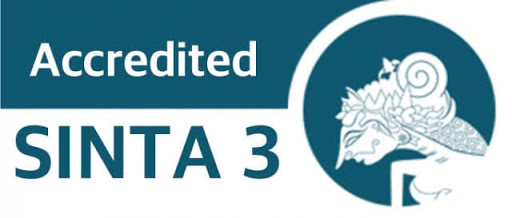WRITING LITERACY AS AN EFFORT TO BUILD POSITIVE CHARACTER OF ELEMENTARY SCHOOL STUDENTS
Abstract
The purposes of the study were to analyze the profile of the development of literacy teaching materials in writing prose and produce prototypes of teaching materials for students' prose writing which included the development of positive characters written by elementary school children. Writing habits with the planting of characters familiarize students to be positive following what is usually done. This is based on the character of students currently still concerning. The model of developing prose literacy for elementary students used is the Plomp model with steps: preliminary research, prototyping phase, and assessment phase. Participants in this study, namely experts, elementary students, and elementary school teachers. Data obtained by triangulating data and analyzed by processing quantitative descriptive data. The research findings indicate that the characteristic profile of students tends to be difficult in writing prose essays. The profile of needs analysis shows that elementary students are very fond of fantasy fairy tales, fables, parables, myths, realistic tales, and sage. The prototype of literacy teaching materials writes valid prose according to the needs of students.
Keywords
Full Text:
PDF (Bahasa Indonesia)References
Ardini, P. P. (2012). Pengaruh Dongeng dan Komunikasi Terhadap Perkembangan Moral Anak Usia 7-8 Tahun. Jurnal Pendidikan Anak, 1(2), 44–58. Retrieved from https://journal.uny.ac.id/index.php/jpa/article/view/2905
Budiyono, H., & Aryanti, P. T. (2016). PENGARUH PENERAPAN MODEL PETA KONSEP DAN PENALARAN TERHADAP KEMAMPUAN MENULIS ESAI MAHASISWA. Bahasa Dan Seni, 44(1), 86–98.
Cahyaningrum, F., Andayani, & Saddhono, K. (2018). PENINGKATAN KETERAMPILAN MENULIS ARGUMENTASI MELALUI MODEL THINK PAIR SHARE DAN MEDIA AUDIOVISUAL PADA SISWA KELAS X-10 SMA NEGERI KEBAKKRAMAT IMPROVING ARGUMENTATION WRITING SKILL THROUGH THINK PAIR SHARE MODEL USING AUDIOVISUAL MEDIA FOR STUDENTS X-10 G. Jurnal Pendidikan Dan Kebudayaan, 3(1), 44–55. https://doi.org/10.24832/jpnk.v3i1.605
Chandra, Mayarnimar, & Habibi, M. (2018). Keterampilan Membaca dan Menulis Permulaan Menggunakan Model VARK untuk Siswa Sekolah Dasar. Jurnal Inovasi Pendidikan Dan Pembelajaran Sekolah Dasar, 2(1), 72–80. https://doi.org/https://doi.org/10.24036/0201821100050-0-00011
Desyafmi, H., Firman, F., & Ifdil, I. (2016). Peningkatan Motivasi Siswa dalam Menyelesaikan Tugas Melalui Layanan Informasi. Konselor, 3(1), 35–41. https://doi.org/10.24036/02014313496-0-00
Gibson, S. A. (2008). Guided Writing Lessons: Second-Grade Students’ Development of Strategic Behavior. Reading Horizons, 48(2), 111–132.
Habibi, M., & Chandra. (2018). Strategi Direct Writing Activity Sebagai Upaya Peningkatan Keterampilan Menulis Deskripsi Bagi Siswa Kelas Ii Sd. Jurnal Inovasi Pendidikan Dan Pembelajaran Sekolah Dasar, 2(1). Retrieved from http://e-journal.unp.ac.id/index.php/jippsd
Habibi, M., Chandra, & Azima, N. F. (2019). Pengembangan Bahan Ajar Menulis Puisi Sebagai Upaya Mewujudkan Literasi Sastra di Sekolah Dasar. ESJ (Elementary School Journal), 9(1), 8–16. Retrieved from http://prosiding.unipma.ac.id/index.php/ISPE/article/view/1241
Habibi, M., Chandra, C., Mahyuddin, R., & Hendri, S. (2018). Validity of Teaching Materials for Writing Poetry Based on Creative Techniques in Elementary Schools. Mimbar Sekolah Dasar, 5(3), 145. https://doi.org/10.17509/mimbar-sd.v5i3.14501
Han, S. (2017). Teaching Google search techniques in an L2 academic writing context. Language Learning & Technology, 21(3), 172–194. Retrieved from http://llt.msu.edu/issues/october2017/hanshin.pdf
Lan, Y. F., Hung, C. L., & Hsu, H. J. (2011). Effects of guided writing strategies on students’ writing attitudes based on media richness theory. Turkish Online Journal of Educational Technology, 10(4), 148–164.
Mayarnimar, & Taufina. (2017). Validity Analysis of the Vark ( Visual , Auditory , Read- Write , and Kinesthetic ) Model – Based Basic Reading and Writing Instructional Materials for the 1St Grade. International Conference for Science Educators and Teachers, 118, 870–874.
Mourssi, A. (2013). Theoretical and practical linguistic shifting from product /guided writing to process writing and recently to the innovated writing process approach in teaching writing for second/foreign language learners. International Journal of Academic Research in Business and Social Sciences, 3(5), 731–751.
Muhammadi, Taufina, & Chandra. (2018). Literasi Membaca untuk Memantapkan Sosial Siswa Sekolah Dasar. LITERA, 17(2), 202–212. https://doi.org/http://dx.doi.org/10.21831/ltr.v17i2.16830
Mumpuni, A., & Nurpratiwiningsih, L. (2017). THE DEVELOPMENT OF A WEB-BASED LEARNING TO IMPROVEOF A CREATIVE WRITING ABILITYOF PGSD STUDENTS.
Nurchasanah, & H.S., S. (2016). PERANGKAT PERKULIAHAN PEMBELAJARAN LITERASI BERBASIS E-LEARNING. Bahasa Dan Seni, 44(2), 224–240.
Plomp, & Nieveen. (2013). An Introduction to Educational Design Research.
Sylvia, & Widiati, U. (2017). THE EFFECT OF WRITTEN RETELLING TECHNIQUE ON STUDENTS ’ READING COMPREHENSION ACROSS PERSONALITY LEARNING STYLES. Bahasa Dan Seni, 45(1), 27–39.
Taufina, & Chandra. (2017). Developing the Big Questions and Bookmark Organizers (BQBO) Strategy-Based Reading Literacy Learning Materials in the 4th Grade of Elementary School. International Conference for Science Educators and Teachers, 118(5), 857–864. Retrieved from https://www.atlantis-press.com/proceedings/icset-17/25886637
Taufina, Chandra, & Kharisma, A. (2019). Technology integration in thematic learning to welcome the era of the industrial revolution 4 . 0 in elementary schools. Proceeding Internasional Seminar of Primary Education, 2, 10–19. https://doi.org/https://doi.org/10.24114/esjpgsd.v9i1.14297
Thomson, S., Hillman, K., & De Bortoli, L. (2013). A teacher’s guide to PISA reading literacy.
Yasa, I. N., Suyitno, I., & Pratiwi, Y. (2016). CRITICAL READING AND WRITING ACROSS THE CURRICULUM ASSISTED BY METACOGNITIVE STRATEGY (BTS) TOWARD STUDENT STUDY CLUB AT UNDIKSHA. Bahasa Dan Seni, 44(1), 32–38.
Yim, S., & Warschauer, M. (2017). Web-Based Collaborative Writing in L2 Contexts: Methodological Insights From Text Mining. Language Learning & Technology, 21(211), 146–165. Retrieved from http://llt.msu.edu/issues/february2017/yimwarschauer.pdf
DOI: http://dx.doi.org/10.33578/pjr.v4i1.7863
Refbacks
- There are currently no refbacks.
Copyright (c) 2020 JURNAL PAJAR (Pendidikan dan Pengajaran)

This work is licensed under a Creative Commons Attribution-NonCommercial-ShareAlike 4.0 International License.
JURNAL PAJAR (Pendidikan dan Pengajaran)
Secretariat
Program Studi Pendidikan Guru Sekolah Dasar
Gedung B1, FKIP Universitas Riau
Kampus Bina Widya Km. 12,5 Simpang Baru Panam
Pekanbaru Riau Indonesia 28293
e-mail : pajar@ejournal.unri.ac.id




